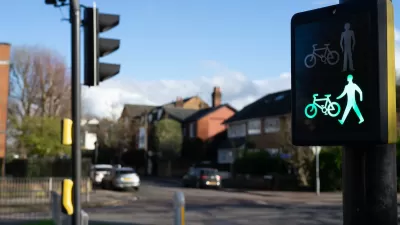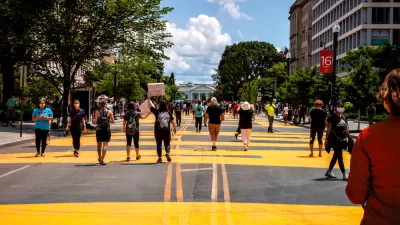New strategies are needed to achieve ambitious safety goals such as Vision Zero. This requires a paradigm shift, a change in the ways risks are measured and potential safety strategies evaluated.

This article was originally published in the Vision Zero Cities Journal, an international journal of traffic safety released by Transportation Alternatives in conjunction with the annual Vision Zero Cities conference.
Despite many traffic safety programs, motor vehicle crashes continue to impose large costs in both developed and developing countries. Although traffic casualty rates declined during most of the 20th century, they have increased since 2011 in the United States, indicating that current traffic safety strategies have fulfilled their potential. New strategies are needed to achieve ambitious safety goals such as Vision Zero. This will require a paradigm shift, a change in the ways risks are measured and potential safety strategies are evaluated. Driving is inherently dangerous, and to reduce total exposure to these dangers, we must reduce driving in the United States.

Traffic fatality rates have steadily increased since 2011, indicating that new approaches will be needed to achieve ambitious safety targets such as Vision Zero.

The U.S. has, by far, the highest traffic fatality rate among peer countries.
The old paradigm assumed that automobile travel is safe overall and focused crash reduction programs on special risks such as impaired and distracted driving. The new paradigm recognizes that all vehicle travel imposes risks, so exposure, the total amount people drive, is a risk factor.
As evidence, consider the large variations in crash rates among U.S. states. Some, such as New York, Hawaii, and Massachusetts have fewer than six traffic deaths per 100,000 residents, while others, such as Arkansas, Wyoming, and Mississippi have more than three times as many. Why? Their residents drive more annual miles at higher speeds than in lower crash-rate states.

Traffic fatality rates increase with annual vehicle-miles travelled per capita.
Similar relationships are found at other geographic scales: per capita, traffic fatality rates tend to increase with mileage for otherwise similar neighborhoods, urban regions, and countries. Residents of compact, walkable urban neighborhoods have about a fifth of the traffic fatality rates as in sprawled, automobile-dependent areas, and communities that improve pedestrian, cyclist, and public transit infrastructure and shift modes experience significant crash reductions.
This has important implications for transportation planning. It suggests that planning decisions that increase total vehicle travel tend to increase total crashes, and vehicle travel reduction strategies can increase safety in addition to their other benefits.

The old and new traffic safety paradigms differ in many ways. The new paradigm considers more solutions.
The current planning paradigm is reductionist, meaning that individual problems were assigned to agencies with narrowly-defined responsibilities. For example, transportation agencies were responsible for reducing traffic congestion, public health agencies for protecting health and safety, and environmental agencies for reducing pollution. Such planning can result in those agencies implementing solutions to the problems within their scope that exacerbate other problems and tend to overlook policies that provide smaller but diverse benefits. The new paradigm supports a more comprehensive analysis that considers multiple goals to identify win-win solutions, policies, and programs that help achieve multiple goals and work in coordination.
Table 2 applies this concept to traffic safety. The left column identifies various planning goals. Policies that encourage safer vehicles, roads, and driving may reduce crash casualties but achieve few other goals and may contradict some. For example, larger vehicles with airbags and antilock brakes increase occupant safety as well as user costs, fuel consumption, and pollution emissions. Safer roads with grade separation, wider lanes, and more clear-space increase roadway costs and, by inducing more vehicle travel, increase traffic problems. Because they feel safer, wider and straighter roads encourage drivers to take additional incremental risks, such as driving slightly faster or being distracted, a phenomenon called risk compensation. Restrictions on young and senior drivers increase their costs and reduce their mobility options. In contrast, lower traffic speeds, Transportation Demand Management (TDM) programs, and Smart Growth policies that reduce total vehicle travel and create more compact communities increase safety and help achieve other community goals, and so can be considered win-win solutions.

Safer vehicles, roads, and driving may reduce crashes but achieve few other goals, and sometimes contradict them. Transportation demand management and smart growth policies increase safety in addition to helping to achieve other planning goals, and so can be considered win-win solutions.
More comprehensive safety analysis tends to support social equity goals. Many conventional safety strategies, such as larger vehicles with more passenger protection, and wider roads with fewer intersections, tend to increase walking and bicycling risks. In contrast, lower traffic speeds, TDM, and Smart Growth tend to improve safety, mobility, and accessibility for people who cannot, should not, or prefer not to drive.
This is not to suggest that traffic safety requires eliminating all driving: some vehicle travel is necessary. However, much driving at the moment is not. Surveys indicate that many people would prefer to drive less, spend less time and money on driving, and rely more on alternatives, provided they are convenient, comfortable, and affordable. In addition, many communities have established vehicle travel reduction targets and are implementing multimodal planning, Smart Growth policies, and TDM programs in order to achieve various community goals. These strategies can also provide large crash reductions, saving lives. When all factors are considered, vehicle travel reductions can be a very cost-effective way to increase safety, and traffic safety benefits can be among the largest benefits of vehicle travel reduction policies.
This article summarizes a more comprehensive report, A New Traffic Safety Paradigm.

Planetizen Federal Action Tracker
A weekly monitor of how Trump’s orders and actions are impacting planners and planning in America.

Congressman Proposes Bill to Rename DC Metro “Trump Train”
The Make Autorail Great Again Act would withhold federal funding to the system until the Washington Metropolitan Area Transit Authority (WMATA), rebrands as the Washington Metropolitan Authority for Greater Access (WMAGA).

The Simple Legislative Tool Transforming Vacant Downtowns
In California, Michigan and Georgia, an easy win is bringing dollars — and delight — back to city centers.

The States Losing Rural Delivery Rooms at an Alarming Pace
In some states, as few as 9% of rural hospitals still deliver babies. As a result, rising pre-term births, no adequate pre-term care and "harrowing" close calls are a growing reality.

The Small South Asian Republic Going all in on EVs
Thanks to one simple policy change less than five years ago, 65% of new cars in this Himalayan country are now electric.

DC Backpedals on Bike Lane Protection, Swaps Barriers for Paint
Citing aesthetic concerns, the city is removing the concrete barriers and flexposts that once separated Arizona Avenue cyclists from motor vehicles.
Urban Design for Planners 1: Software Tools
This six-course series explores essential urban design concepts using open source software and equips planners with the tools they need to participate fully in the urban design process.
Planning for Universal Design
Learn the tools for implementing Universal Design in planning regulations.
Smith Gee Studio
City of Charlotte
City of Camden Redevelopment Agency
City of Astoria
Transportation Research & Education Center (TREC) at Portland State University
US High Speed Rail Association
City of Camden Redevelopment Agency
Municipality of Princeton (NJ)






























